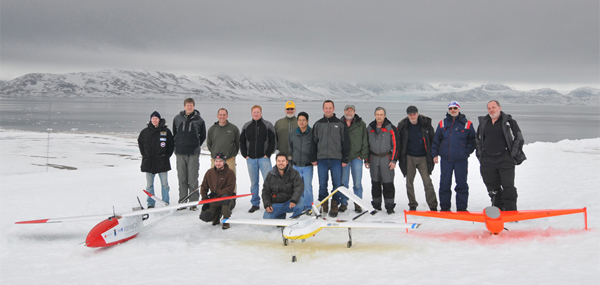
UAS from Norway (left), the United States (centre), and Russia (right) with the flight teams in Ny-Alesund, Svalbard, Norway. Photo Credit: Kjell-Sture Johansen/Norut
An international research team, including scientists from NOAA’s Pacific Marine Environmental Lab in Seattle, completed a series of unmanned flights over the Arctic on April 30.
The team is investigating the potential role of black carbon, or soot, in the rapidly changing Arctic climate. Also participating in the Coordinated Investigation of Climate-Cryosphere Interactions project are scientists from Norway, Russia, Germany, Italy, and China. The mission began in early April.
The NOAA flight team used two small aircraft, the Mantas, equipped with sensors to detect and measure black carbon levels. The Mantas flew 18 flights for a total of 38 hours. This was the first science mission for the NOAA Mantas and flight team and the first time three unmanned aircraft from three countries participated in a joint Arctic science mission. The NOAA Cooperative Institute for Research in Environmental Sciences at the University of Colorado and the Joint Institute for Study of the Atmosphere and Ocean at the University of Washington are also part of the NOAA team.
NOAA Cooperative Institutes are academic and non-profit research institutions that demonstrate the highest level of performance and conduct research that supports NOAA’s mission goals and strategic plan. Cooperative Institutes also help educate and train the next generation of NOAA’s and the nation’s scientific workforce.
The Arctic climate is changing faster than some scientists expected. A continuing decline in summer sea ice, warmer temperatures, changes in vegetation, and other indicators signal polar changes that affect the rest of the globe. Climate models indicate that black carbon is contributing to this warming. Scientists say much of the black carbon in the Arctic comes from biomass and fossil fuel burning in Europe, Russia, northern Asia, and North America. The goals of CICCI include determining the sources of black carbon that are deposited to snow and ice surfaces in the Arctic and assessing model-based estimates of the resulting warming.
NOAA’s mission is to understand and predict changes in the Earth’s environment, from the depths of the ocean to the surface of the sun, and to conserve and manage our coastal and marine resources.
Source: NOAA
